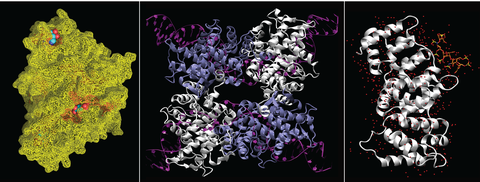Research
Structure-based computational approaches applied to rational engineering and de novo design for target/drug discovery and biotechnology innovation.
Rational engineering and de novo design for biotechnological and/or medical applications:
- De novo rational design of molecular scaffolds mimicking protein interactions for specific interference in cell signaling processes
We apply molecular modelling and computer simulation techniques for designing molecules with pharmacological/biotechnological interest. On one hand, we make use of scaffolds that are available in nature and rationally modify them in order to improve their properties in terms of stability, affinity and specificity. On the other hand, we de novo design scaffolds that mimic natural protein 3D templates involved in interactions of pharmacological relevance.
- Rational engineering of biomaterials for tissue regeneration
GAGs (glycosaminoglycans) are common constituents of cell surfaces and extracellular matrices, and their interactions with a wide variety of molecules such as growth factors and cytokines play a prominent role in basic biological phenomena like cell adhesion, migration, proliferation and differentiation. Thanks to these biocharacteristics, attachment of GAGs to biomaterials offers a great opportunity to modulate tissue response and create an appropriate environment for cellular signalling, both important issues in tissue engineering and regeneration. In close collaboration with experimentalists, we work on the characterization of the structural requirements for protein-GAG binding to understand the molecular basis of the affinity and specificity governing these interactions. We apply computational modelling and simulation techniques to understand the hetereogeneity of the GAG component and to study structural and physical characteristics of GAGs in the context of their interaction with their biological binding-partners. Our studies help in the design of building blocks for chemical and modular synthesis of GAGs-derivatives and matrix scaffolds in biomaterials to promote bio-specific cell behaviour.
We have recently succeded in the rational design of new molecules with bone tissue regenerative properties (Biomaterials 2023; 297:122105).
A Sweet Solution to a Cracking Problem: Scientists Design New Bio-Inspired Molecules to Promote Bone Regeneration. https://tud.link/nuxi
Work funded by the German Research Council (DFG; TransRegio 67) and the Federal Ministry of Education and Research (BMBF).
- Rational engineering of enzymes with improved anti-HIV functional properties
We collaborate with experimental groups in the generation of new DNA recombinases with improved properties to excise HIV from infected human cells. The group of Prof. Buchholz (Med. Fac. TUD) uses in vitro evolution strategies to evolve DNA recombinases, which have been recently shown to be able to excise a sub-classe of HIV from human HIV infected cells (Sarkar et al, Science 2007; DOI: 10.1126/science.1141453). New recombinases are being engineered with improved properties, and we use computational approaches to rationalize the molecular recognition of these enzymes with the aim of establishing the bases for their structure-function relationships and to be able to rationally design evolved DNA recombinases with the desired properties of stability and specificity for different DNA sequences.
Work funded by the German Research Council (DFG).
- Rational design of inhibitors of the Anaphase Promoting Complex/Cyclosome (APC/C) as leads for drug development
The ubiquitin E3 ligase Anaphase Promoting Complex or Cyclosome (APC/C) is emerging as an attractive drug target in cancer therapy to affect specifically rapidly dividing cancer cells as a first step for gaining specificity in treatment. We use computer-aided molecular design techniques to rationally design molecules inhibiting the APC/C complex and, in close collaboration with the group of Jörg Mansfeld (BIOTEC TUD),biochemical and cell biological approaches are applied to experimentally evaluate the inhibitory potential of our structure-based rationally designed molecules our goal is to obtain potent and specific APC/C inhibitors with optimized properties as lead molecules for drug development for cancer treatment.
Work funded by the German Research Council (DFG).
Integrative bioinformatics for structure-based functional annotation of uncharacterized proteins and new target discovery:
- Discovery and functional annotation of novel proteins using 3D descriptors
We combine fold recognition approaches and the development structure-based functional descriptors (3D descriptors) of protein folds for automatic genome-wide discovery of remote homologues members of different structural protein families. We work on the identification and functional characterization of novel human proteins involved in inflammatory, immune and cancer processes that cannot be characterized by sequence -based methods due to their low or not existing sequence similarity to others.
Detailed characterization of protein interfaces and implications for protein function and ligand design:
- Comparative analysis and prediction of protein-protein and protein-ligand interactions
We develop computational tools to extract, analyze and classify protein interaction information from the PDB in an automatic and comparative fashion. These methods help to obtain an accurate description of protein interfaces, which is needed in order to gain insight about protein function and to be able to properly characterize protein networks.
- Analysis of the role of solvent in protein recognition
We carry out studies that highlight the importance of including solvent in protein interface definition and consequently in protein interaction studies. Water molecules can play an important role in interaction conservation in protein interfaces by allowing sequence variability. Our studies help to deepen our understanding of the physico-chemical nature underlying protein interactions and strengthen the idea of including solvent to qualitatively improve the accuracy of folding, docking and rational design algorithms.

